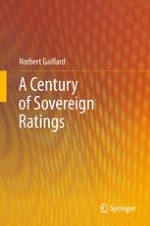2012 | OriginalPaper | Buchkapitel
9. Fitch, Moody’s, and S&P Sovereign Ratings and EMBI Global Spreads: Lessons from 1993–2007
verfasst von : Norbert Gaillard
Erschienen in: A Century of Sovereign Ratings
Verlag: Springer New York
Aktivieren Sie unsere intelligente Suche, um passende Fachinhalte oder Patente zu finden.
Wählen Sie Textabschnitte aus um mit Künstlicher Intelligenz passenden Patente zu finden. powered by
Markieren Sie Textabschnitte, um KI-gestützt weitere passende Inhalte zu finden. powered by
